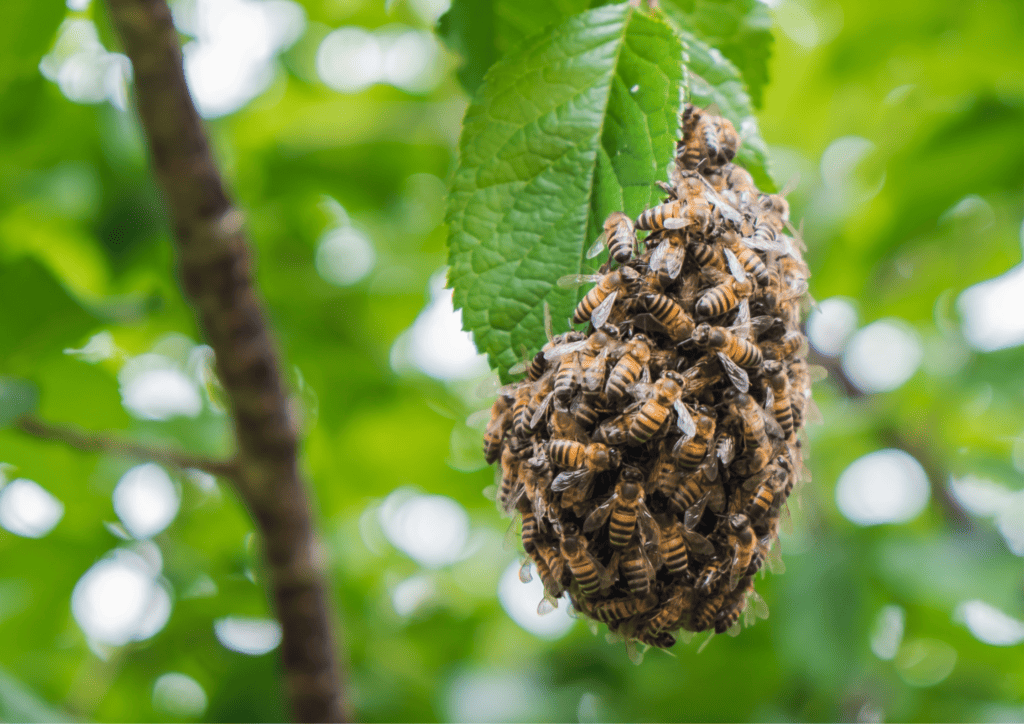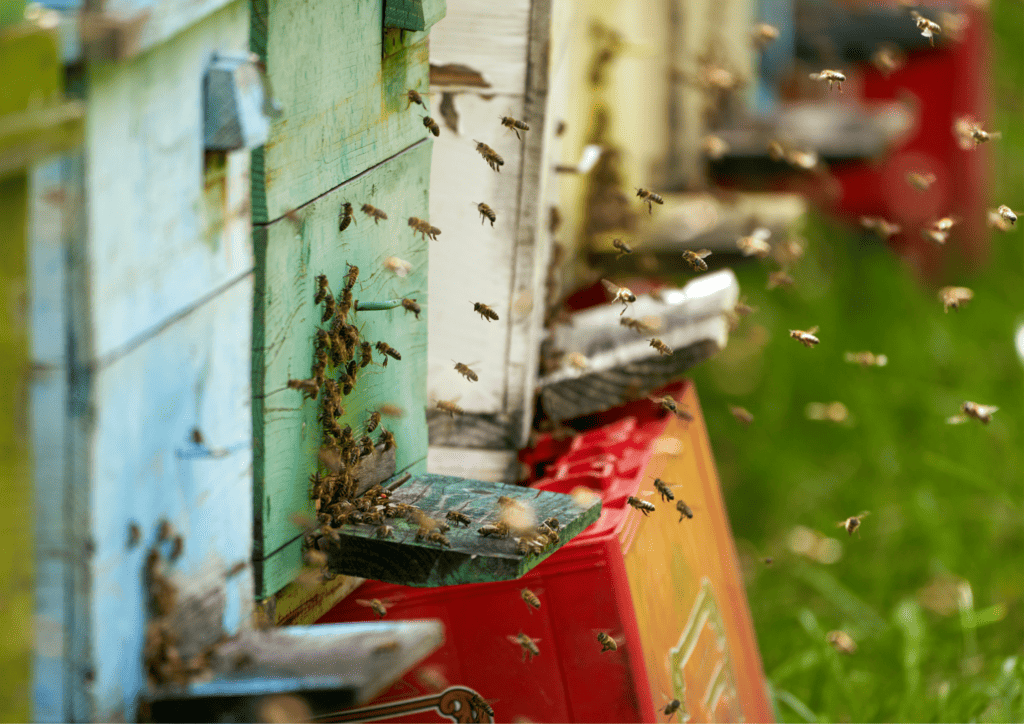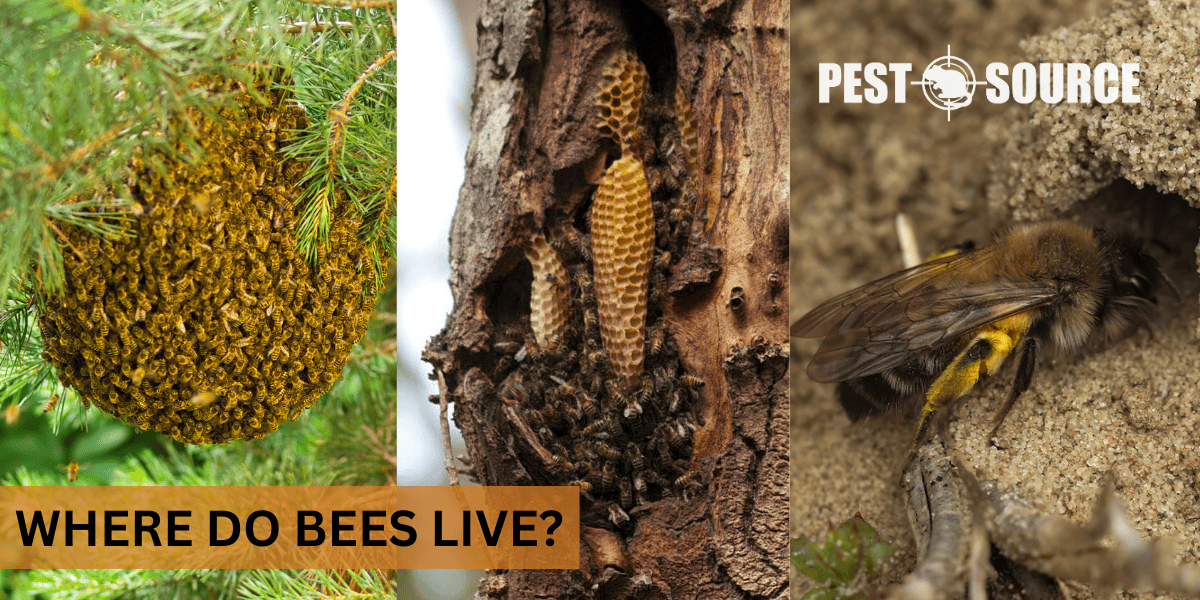Bees live in a variety of habitats, including forests, gardens, meadows, and even urban areas, where they make their homes in hives, trees, or underground burrows. This article explores the diverse living environments of bees, from the meticulously constructed hives of honeybees to the solitary nests of wild bees, highlighting their adaptability and the importance of preserving their habitats for ecological balance.
POINTS
- Bees inhabit a variety of natural habitats globally, with their nesting preferences ranging from hives and hollow trees to underground burrows.
- The survival of bees is dependent on environmental factors such as floral diversity, climate, and the absence of harmful chemicals, with their role as pollinators being crucial for ecosystem health.
- Honey bees are adaptable and found in diverse biomes worldwide, with their distribution influenced by the availability of flowers and suitable climates.
- Conservation efforts, including creating bee-friendly environments and supporting organic farming, are vital for the protection and sustainability of bee habitats.
- Bee nests, whether wild or man-made, are marvels of natural engineering with intricate designs for space efficiency, temperature regulation, and protection against predators.
Where to Find Bees?
Bees, the industrious pollinators of our ecosystems, inhabit a variety of natural habitats across the globe. Their presence is crucial for the pollination of flowers, fruits, and other plants, making them an essential part of our biodiversity. Understanding where bees live helps us appreciate their role in nature and the necessity to protect their environments.
Types of Structures for Nesting
Bees display remarkable diversity in their choice of nesting sites. The types of structures or natural formations bees use for nesting include:
- Hives: This is the most well-known home for honey bees, which are social insects living in large colonies. Hives are intricate structures composed of wax, featuring a series of hexagonal cells that serve as storage for honey and pollen, as well as a nursery for larvae.
- Hollow Trees: Many wild bees, including some species of honey bees, prefer the natural shelter of hollow trees. These cavities offer protection from the elements and predators, making them ideal for raising their young and storing food reserves.
- Underground Burrows: Some bee species, such as bumblebees and solitary bees, opt for underground burrows. These can be naturally occurring or excavated by the bees themselves. The burrows provide a stable temperature and safeguard against many threats.
What is a Bee’s Habitat?
A bee’s habitat encompasses all the environmental factors that are essential for their survival. This includes an abundance of flowering plants for nectar and pollen, access to water, and safe nesting sites. Bees thrive in environments that offer a rich variety of flora, which in turn supports their role as pollinators.
Environmental Factors and Ecosystem Roles
Bees are integral to their ecosystems, contributing to the growth and reproduction of plants through pollination. The environmental factors that impact bees include:
- Floral Diversity: A range of flowering plants is critical for bees, providing the necessary nutrients throughout the seasons.
- Climate: Temperature and weather conditions influence bee activity and survival. Bees require warm temperatures to forage and are sensitive to extreme weather events.
- Pesticides and Chemicals: Exposure to harmful chemicals can devastate bee populations. A habitat free from these toxins is crucial for their health.
Bees, in turn, impact their environment by facilitating cross-pollination, which is vital for genetic diversity among plant populations.
Where Do Honey Bees Live in the World?
Honey bees are found on every continent except Antarctica, adapting to a wide range of environments. They are most commonly associated with regions that have abundant flowering plants, including Europe, Africa, and the Americas.

Global Distribution and Biomes
Honey bees inhabit various biomes, from tropical rainforests to temperate deciduous forests. Their distribution is largely influenced by the availability of flowers and suitable climates for year-round activity. Key regions include:
- Europe: Known for its diverse beekeeping practices, Europe has a long history with honey bees, especially the well-known species Apis mellifera.
- Africa: The continent boasts a high diversity of honey bee species, adapted to its varied climates and ecosystems.
- North America: Honey bees were introduced by European settlers and have since become widespread, playing a significant role in agriculture.
The climate of a region greatly affects the population and habitat distribution of honey bees, with milder climates supporting larger populations.
How Do Bees Live?
Bees exhibit a fascinating array of social structures and lifestyles, ranging from the highly organized social colonies to the independent solitary bees. Each species has adapted to its environment in unique ways, which dictate their behaviors and roles within the ecosystem.
Social Structure and Colony Life
Social bees, such as honey bees and bumblebees, live in well-structured colonies with a clear division of labor. These colonies consist of:
- A single queen: The mother of most, if not all, bees in the colony. Her primary role is to lay eggs.
- Workers: These are sterile females that perform the tasks of foraging, nursing, and defending the hive.
- Drones: Male bees whose sole purpose is to mate with a new queen.
Solitary bees, on the other hand, operate alone. Each female is responsible for her own nesting and provisioning for her offspring.
Nest-Building and Foraging
Bees are adept builders and foragers. Social bees construct complex nests, like the hexagonal wax cells of honey bee hives, while solitary bees might carve out individual nests in wood or soil. Foraging behavior is tuned to the availability of floral resources, and bees have evolved to be efficient pollinators, often specializing in specific types of flowers which they visit in a phenomenon known as ‘flower fidelity’.
Bee Ecosystem and Biome
Bees are a keystone species in many ecosystems, performing the critical service of pollination which allows plant communities to reproduce and thrive. The specific roles they play can vary greatly depending on the biome they inhabit.
Interaction with the Ecosystem
In their role as pollinators, bees interact with plants in a mutualistic relationship: bees collect nectar and pollen for nutrition, and in the process, they facilitate the transfer of pollen between flowers. This interaction is vital for the survival of many plant species and, consequently, the animals that depend on those plants for food and shelter.
Types of Biomes
Bees are adaptable and can be found in a range of biomes, including:
- Temperate Forests: These regions offer a seasonal array of flowering plants that support diverse bee populations.
- Tropical Rainforests: The high biodiversity provides a constant source of nectar and pollen year-round.
- Deserts: Even in arid environments, bees can be found, often specialized to the unique flora present.
Each biome presents different challenges, from water scarcity in deserts to reduced seasonal availability of resources in temperate zones, shaping the bees’ behaviors and adaptations.
Where Are Bees Most Commonly Found?
Bees are most commonly found in environments that provide a rich supply of flowering plants and nesting sites. These conditions support the highest densities of bee populations.
Environments Supporting High Bee Densities
- Wildflower Meadows: These habitats are ideal for bees due to the abundance of pollen and nectar sources.
- Forests and Woodlands: Offering both food and shelter, these areas are conducive to both solitary and social bees.
- Agricultural Areas: Farms with diverse cropping systems can support large populations of bees, provided that pesticide use is managed or minimized.
Regions where domesticated bees are prevalent include areas with large-scale agriculture requiring pollination services, such as orchards and fields of crops like almonds and blueberries.
Where Can Honey Bees Be Found?
Honey bees, known for their importance in agriculture and the environment, can be found in a variety of habitats around the world. They are incredibly adaptable and have been successfully introduced to many areas by humans for the purpose of pollination and honey production.
Habitats and Conditions for Honey Bees
Honey bees flourish in conditions that provide:
- Diverse Flora: An environment rich in a variety of flowering plants is essential for a steady food supply.
- Mild Climate: Temperate climates with mild winters and warm summers are ideal for honey bee activity and survival.
- Water Sources: Access to water is necessary for hive cooling and hydration.
These habitats range from rural farmlands to urban gardens, demonstrating the honey bee’s adaptability. In urban settings, honey bees can often be found in community gardens, parks, and on rooftops, where beekeeping enthusiasts may establish hives.
Conservation Efforts and Habitat Protection
The protection of honey bee habitats is crucial for their survival and the continued benefit they provide through pollination. Conservation efforts include:
- Creating Bee-Friendly Gardens: Planting a variety of bee-attracting flowers and reducing pesticide use.
- Supporting Organic Farming: Organic farms often provide safer environments for bees due to the restricted use of harmful chemicals.
- Habitat Restoration: Efforts to restore natural habitats can help support wild bee populations.
These efforts not only benefit honey bees but also the myriad of other pollinators that share their environment.
What Do Bees Live In?
Bees live in a range of structures, from the natural to the man-made. Each species has its own preferences and requirements for nesting and living.
Nesting Sites and Living Structures
Bees occupy several types of nests:
- Wild Nests: These can be found in hollow trees, rock crevices, or underground. They are typically constructed by the bees themselves and can vary greatly in size and complexity.
- Man-Made Hives: Beekeepers provide hives for honey bees, which can range from simple boxes to elaborate, multi-chambered structures designed to facilitate honey harvesting and colony management.

Construction and Architecture
The construction of bee nests is a marvel of natural engineering:
- Honey Bee Hives: Comprised of wax cells in a double-layered hexagonal pattern, these structures are efficient in terms of space and require less wax to construct, saving the bees valuable energy.
- Solitary Bee Nests: Solitary bees may use mud, plant fibers, or even their own saliva to construct individual cells for their offspring.
The architecture of bee nests is not only functional but also ensures the safety and well-being of the colony or individual bee, protecting against predators and harsh environmental conditions.
Bees Habitat Facts
To wrap up our exploration of bee habitats, here are some intriguing facts that offer deeper insight into their world:
- Bee Communication: Bees communicate with each other through a series of dances, which can indicate the direction and distance of food sources relative to the sun.
- Thermoregulation: Honey bee colonies maintain a consistent internal temperature of about 95°F (35°C) year-round, which is vital for the survival of the larvae and the queen.
- Habitat Adaptation: Bees have been found at high altitudes and in urban environments, demonstrating their incredible adaptability to different habitats.
- Conservation Status: Many bee species are threatened by habitat loss, pesticides, and diseases. Efforts to map bee populations and protect their habitats are ongoing.
Where Do Bees Go in the Winter?
Where bees go in the winter varies by species. Honeybees stay inside their hives, clustering together to maintain warmth and feed on stored honey, while many solitary bees and bumblebees enter a state of hibernation in underground burrows, hollow stems, or other secluded places. Worker bees generate heat by vibrating their wing muscles, keeping the hive at a stable temperature to protect the queen and ensure the colony’s survival through cold months. Other species might migrate to warmer areas or have adapted unique strategies for winter survival.



